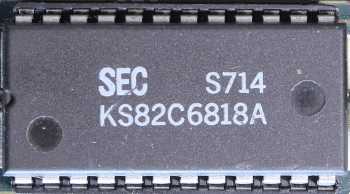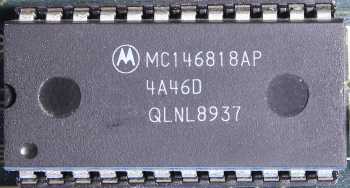Main difference between variants:
- 6818A (this one): pin 1 is MOT (bus type), pin 16 is STBY
- 6818: pin 1 and 16 are not connected (unused)
- W85C178: 6818A compatible with 114 bytes of non voltatile storage
From Mototrola datasheet:
The MC146818A Real-Time Clock plus RAM is a peripheral device which includes the unique MOTEL concept for use with various microprocessors, microcomputers, and larger computers. This part combines three unique features: a complete time-of-day clock with alarm and one hundred year calendar, a programmable periodic interrupt and square-wave generator, and 50 bytes of low-power static RAM. The MC146818AFN uses high-speed CMOS technology to interface with 1MHz processor busses, while consuming very little power.
The Real-Time Clock plus RAM has two distinct uses. First, it is designed as a battery powered CMOS part (in an otherwise NMOS/TTL system) including all the common battery backed-up functions such as RAM, time, and calendar. Secondly, the MC146818A may be used with a CMOS microprocessor to relieve the software of the timekeeping workload and to extend the available RAM of an MPU such as the MC146805E2
Features:
- Low-Power, High-Speed, High-Density CMOS
- Internal Time Base and Oscillator
- Counts Seconds, Minutes, and Hours of the Day
- Counts Days of the Week, Date, Month, and Year
- 3 V to 6 V Operation
- Time Base Input Options: 4.194304 MHz, 1.048576 MHz, or 32,768 kHz
- Time Base Oscillator for Parallel Resonant Crystals
- 40 to 200 uW Typical Operating Power at Low Frequency Time Base
- 4.0 to 20 mW Typical Operating Power at High Frequency Time Base
- Binary or BCD Representation of Time, Calendar, and Alarm
- 12- or 24-Hour Clock with AM and PM in 12-Hour Mode
- Daylight Savings Time Option
- Automatic End of Month Recognition
- Automatic Leap Year Compensation
- Microprocessor Bus Compatible
- Selectable Between Motorola and Competitor Bus Timing
- Multiplexed Bus for Pin Efficiency
- Interfaced with Software as 64 RAM Locations
- 14 Bytes of Clock and Control Registers
- 50 Bytes of General Purpose RAM
- Status Bit Indicates Data Integrity
- Bus Compatible Interrupt Signals (IRQ)
- Three Interrupts are Separately Software Maskable and Testable
- Time-of-Day Alarm, Once-per-Second to Once-per-Day
- Periodic Rates from 30.5 us to 500 ms
- End-of-Clock Update Cycle
- Programmable Square-Wave Output Signal
- Clock Output May Be Used as Microprocessor Clock Input
- At Time Base Frequency /1 or /4
Disclaimer
The info found in this page might not be entirely correct. Check out this guide to learn how you can improve it.
 Image 1 of 9 (Carlos S. M.)
Image 1 of 9 (Carlos S. M.)
 Image 2 of 9 (computerguy096)
Image 2 of 9 (computerguy096)
 Image 3 of 9 (Helen_Croft)
Image 3 of 9 (Helen_Croft)
 Image 4 of 9 (pshipkov)
Image 4 of 9 (pshipkov)
 Image 5 of 9
Image 5 of 9
 Image 6 of 9 (computerguy096)
Image 6 of 9 (computerguy096)
 Image 7 of 9 (Fernando Espino)
Image 7 of 9 (Fernando Espino)
 Image 8 of 9 (Circuit Rewind)
Image 8 of 9 (Circuit Rewind)
 Image 9 of 9 (Vipeg)
Image 9 of 9 (Vipeg)